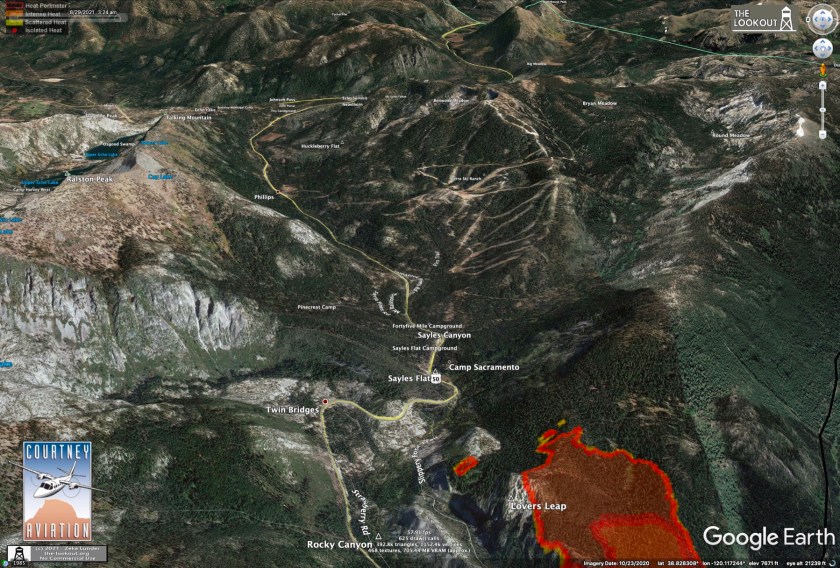UPDATE: 8/29/2021, 6:00pm.
As of 5:20pm on August 29, the Caldor Fire had run to Phillips, within about 2.5 miles of Nebelhorn/Echo Summit. Heat mapping as of 5:20pm, 8/29/2021. Spots have been reported on the Echo Lake-side of the ridge north of Phillips at about 6pm.
Looking east over Highway 50.
Looking east over Sierra-At-Tahoe resort.
A wider view to northeast, showing proximity to Echo Lake and dropoff to Meyers.
The fire was 2.5 miles from Nebelhorn/Echo Summit at 5:20pm on August 29.
This image shows dynamics of today’s wind-driven fire runs, starting west of Strawberry where fire crossed bulldozer lines last night. There were three different heads of this fire running here today. One stayed on north side of Highway 50, another took off from a spot fire at Lovers Leap, and the southernmost took off over the ridge between Strawberry and Sierra-At-Tahoe. Having such a broad expanse of well-established heat in the basin of Sierra-At-Tahoe creates challenges for firefighting, as there is a multitude of places which can flare up in the right winds and send runs east toward the dropoff to Meyers.
UPDATE: 8/29/2021, 3:45pm.
MANDATORY EVACUATIONS FOR MEYERS AND CHRISTMAS VALLEY.
Fire is on the move to the east and southeast today running about a mile toward Leek Springs Lookout on the SE flank of the fire. The webcams on Armstrong Lookout have been showing this extreme fire behavior since shortly after dawn this morning. The fire has burned on both sides of Strawberry, but no structures have been lost here, yet. The main head of the fire has made a major run up the Highway 50 corridor and is either inside of, or nearly to the Sierra-At-Tahoe ski resort. There are reports of spot fires as far ahead of the fire as Ralston Lake, to the northwest of Echo Lake. The fire is burning intensely on the divide between SAT and Strawberry Creek. Heat from this is visible on a new infrared camera that has just been installed on the top of Heavenly Valley.
Here is coarse-scale heat detection data from 3pm on August 29. I usually don’t post this as authoritative intel, as it can be off by miles, but given other reports, this seems to be fairly accurate. Sierra-At-Tahoe is on middle-right.
General map showing hot areas of Caldor Fire at 3pm, 8/29/2021.
As mentioned earlier, the east head of the fire is now in an area where the topography, winds and fuel loading are all in alignment for uncontrollable, high-intensity fire behavior. Firefighters may try to make a stand somewhere around Echo Lake, but under current conditions this will have a low likelihood of success. Creating wide firelines and choreographing a major firing operation — where we scrape a large fireline and then light fires on the fire-side of it to create an area without available fuels in front of the fire — is a very difficult thing to pull off under the best conditions. Major burning operations usually take days of preparation and require massive numbers of firefighters to prepare the fireline, clear out fuels on both sides of the line, install hoselays, and do other prep work like falling snags that can catch fire and fall across the line.
This prep work has not been done to the east of where the fire is currently burning, and deploying the hundreds of firefighters needed is now likely too dangerous, even if there was a workable plan. Given the forecasts for major winds over the next few days, it seems very likely the fire is going to burn past Echo Summit. If you are between South Lake Tahoe and Meyers, don’t let the fact you are not inside a designated evacuation warning zone lull you into any extra comfort. Here is a link to current evacuations orders and warnings.
8/29/2021, 7:00 am.
Yesterday was an active day on the Caldor Fire.
Summary
Fire moved to Strawberry on both sides of Highway 50, made a run up the the north-facing slope to the east of the community and became established at Lover’s Leap. As of 3:30am, it was 2.5 miles upcanyon from where it had been 28 hours earlier, past major dozer lines in Strawberry Creek. Fire is now 5.5 miles from Echo Summit. The portion of fire on the north side of Highway 50 moved 1.25 miles east in same 28 hour period.
Elsewhere, bulldozer firelines south of Cody Lake were still holding at 3:30am. West of there, the fire had bumped into the 2019 Caples Prescribed Burn/Wildfire. Adjacent to Mormon Emigrant Trail, the fire grew about 2,000 acres to the south. The large spot fire on the southern edge of fire burned back into the main fire and continued to back actively into Cat Creek. The south side of the fire around Croft still looks like it is cooling off. No new spread downcanyon in Middle Fork Consumnes River. On the northwest corner of the fire, east of Pleasant Valley, fire spread about 1/2 mile west in Camp Creek, and backed further into the North Fork Consumnes River.
Because a lot of our suppression resources are tied up protecting the Highway 50 corridor and communities on the northwest of the fire, the fire may be able to back actively through the Caples Burn, but is unlikely to kill many of the larger trees here. We need large prescribed fire blocks like Caples all over our landscapes if we are to have any hope of avoiding more megafire like Dixie, Caldor, Creek, Carr, Camp, Delta — to name a few of the worst from past three years. There is no fire-free option for our forests. Burn it, or watch it burn.
Forecasts























